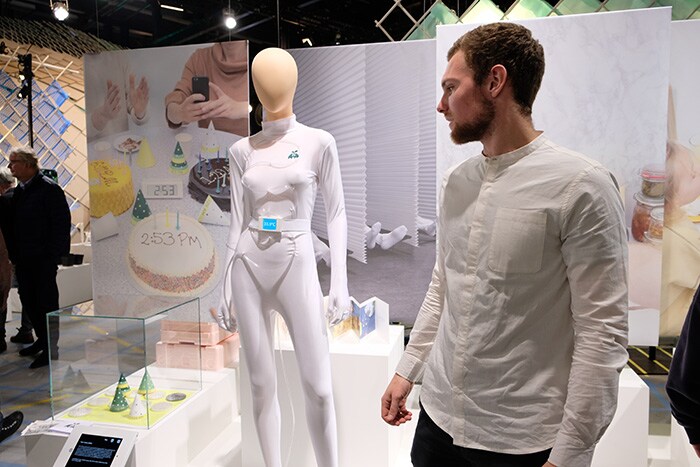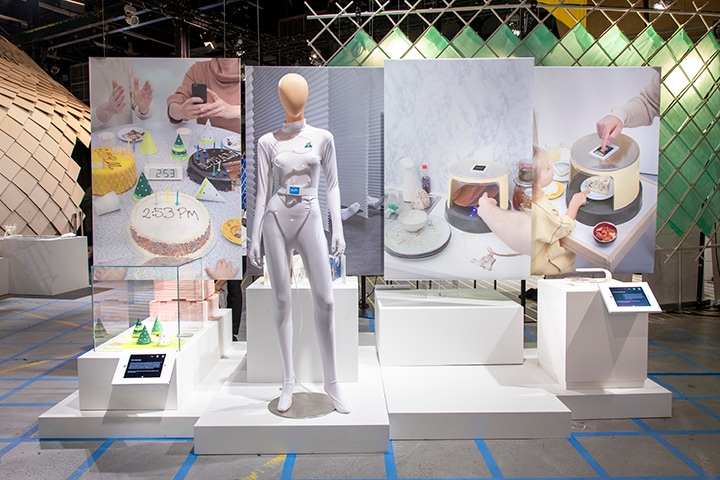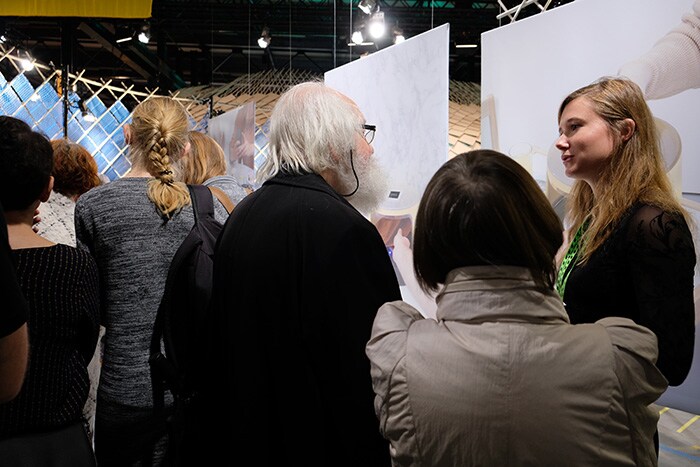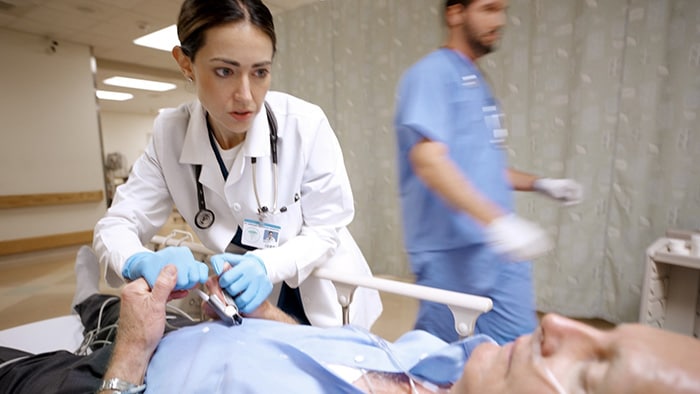For English see below
Studenten TU/e en Design Academy werkten speciaal voor Dutch Design Week toekomstbeelden uit
En ze leefden nog lang en gelukkig. Sprookje of werkelijkheid? We worden steeds ouder en de manier waarop we dat willen doen, vraagt om meer en andere zorg. Maar hoe moet die er dan uitzien? Om dat te kunnen bepalen, helpt het om de toekomst te verbeelden. Ontwerpers blinken daarin uit en speciaal voor Dutch Design Week 2019 bundelden enkelen van hen hun krachten om binnen de Embassy of Health te zoeken naar een nieuwe balans tussen technologie en natuur, tussen perfectie en imperfectie en tussen formele en informele zorg. Met de tentoonstelling Chronic Health: It’s only human? toont deze Embassy de kracht van design bij de transities in de zorg, evenals de dilemma’s van de zorg. Philips Experience Design werkte daarvoor dit jaar, onder leiding van experimental designer Frank Kolkman, opnieuw samen met enkele studenten van de TU/e en de Design Academy. Onder de titel ‘Future of humanity or futuristic humans?’ gingen zij op zoek naar de toekomst.

Verrassende inzichten
De gesteldheid van de mens en de gesteldheid van onze planeet zijn onlosmakelijk met elkaar verbonden. Een gezond leven vraagt ook om gezonde voeding, frisse lucht en schoon water. Hoe dragen we zorg voor de toekomst, voor de gezondheid van onze kinderen én van de planeet? Geven we onze zorg vorm op basis van beschikbare natuurlijke grondstoffen? Of passen we onze menselijke natuur aan om het behoud van onze planeet te waarborgen? Dit vroegen Philips Experience Design en experimental designer Frank Kolkman zich af, voor deze editie van Dutch Design Week. Ze werden bij het uitwerken van de toekomstscenario’s geholpen door studenten van TU/e en Design Academy. Hiervoor gebruikten zij een door Reon Brand (Principle Design Researcher bij Philips Experience Design) ontwikkelde methode en daar kwamen verrassende inzichten uit. Door wetenschap, design en storytelling te combineren, zetten vier bedachte en tentoongestelde projecten bezoekers aan het denken.
Dit hoeft niet per se de toekomst te zijn, maar het is goed om daarover van gedachten te wisselen.
Matthijs Koerts
Student Design Academy
Zoals Hiber Nation; het drie maanden in winterslaap brengen van de mens. Matthijs Koerts (21), student Design Academy, werkte samen met vier anderen aan deze verhaallijn. “We wilden kijken hoe we een meer gematigd ecosysteem konden opzetten en daarbij hebben we gekeken naar hoe dieren daar mee omgaan. Leren van de natuur en dan een vertaalslag maken naar wat nodig is voor ons. Maar ook wat de sociale impact daarvan is op ons, mensen.” De reacties op de tentoonstelling zijn wisselend. Sommige mensen lijkt het heerlijk om drie maanden te slapen, maar anderen voelen zich beperkt door het idee. Matthijs: “Die zijn dan zelfs een beetje verontwaardigd. ‘Ga jij mij vertellen dat ik drie maanden niets moet doen?’ zeggen ze dan. Maar dat was het ook doel. Dit hoeft niet per se de toekomst te zijn. Het is goed om daarover met elkaar van gedachten te wisselen.”

Verademing
In de projectgroep van Matthijs zat ook een studente van de TU/e. De samenwerking met haar vond hij een verademing. “In Eindhoven gebeurt zoveel op dit vlak en ook veel tegelijk, maar de links worden niet vaak genoeg gelegd. Terwijl juist samenwerken in een groep met verschillende kwaliteiten en verschillende experts projecten sterker kunnen maken.”
Bezoekers van de tentoonstelling denken zelfs al verder.
Jessie Harms
Studente TU/e
Dat vindt ook Jessie Harms (23), master student Industrial Design aan de TU/e. Zij werkte aan het project ‘Dish scanner; scan instead of wash’. “De studenten van de Design Academy hebben een andere kijk op dingen. Ze durven te dromen, terwijl ik heel concreet ben en uitga van wetenschappelijke informatie. Dat werkte heel goed: zij schetsten een droom, ik zocht uit of het toepasbaar kon zijn. Door met hen samen te werken, is mijn blik wijder geworden.” Ze krijgt veel positieve reacties op de ‘Dish scanner’. Het idee daarachter heeft zowel met duurzaamheid als met gezondheid te maken. “We zijn bang geworden voor bacteriën en willen die het liefst zoveel mogelijk vermijden, terwijl er in verhouding maar weinig bacteriën zijn waar we ziek van worden. De goede bacteriën hebben we juist nodig voor ons immuunsysteem. Met onze scanner zou je kunnen zien welke bacteriën er op je servies achterblijven na het eten. Blijkt dat dit goede bacteriën zijn? Dan hoef je het dus niet af te wassen.” De mensen die ze spreekt tijdens Dutch Design Week blijken erg open te staan voor het idee. Jessie: “Ze denken zelfs al verder. Dat je niet alleen de afwas scant, maar ook je voedsel bijvoorbeeld, om te zien of je het nog kunt eten.”

Waardevol
De methode van Reon Brand vonden zowel Jessie als Matthijs leerzaam om mee te werken. Matthijs: “Die zet je echt aan het nadenken. Vaak ga je heel erg uit van je eigen omgeving, maar hiermee moesten we ons echt afvragen: wat is het eindpunt van een bepaalde ontwikkeling?” Jessie: “De methode helpt heel erg om je echt in de toekomst te laten kijken. Dat vond ik heel waardevol. Het is interessant om te zien hoe mensen daarop reageren.” Het werken met Frank Kolkman is ze ook allebei goed bevallen. “Frank is heel opbouwend en hij wil je project echt verder helpen”, aldus Jessie. Frank zelf vond het ook dit jaar weer zelf weer indrukwekkend en leerzaam om met de studenten te werken. “Ze dagen ons als designers ook uit om verder te denken. En, ook heel belangrijk: het gaat hier over de toekomst. En die toekomst, dat zijn zij.” Meer informatie is te vinden op: https://www.worlddesignembassies.com/embassies/health/ https://www.ddw.nl/nl/programma/1777/embassy-of-health U CREATE, Stimuleringsfonds Creatieve Industrie, Philips Experience Design, Máxima MC, Waag en DDF werken als partners samen in de Embassy of Health. Met de tentoonstelling Chronic Health tonen zij de kracht van design bij de transitie in de zorg. Curatoren: Paulien Melis - Jetske van Oosten - Gjilke Keuning Ambassadeur: Frank Kolkman
Live happily ever after? Philips Experience Design investigates how
Students TU/e and Design Academy worked out future images especially for Dutch Design Week
And they lived happily ever after. Fairy tale or reality? We are getting older and the way we want to do that requires more and different care. But what should it look like? In order to determine that, it helps to imagine the future. Designers excel in this and especially for Dutch Design Week 2019 some of them joined forces to search within the Embassy of Health for a new balance between technology and nature, between perfection and imperfection and between formal and informal care. With the exhibition Chronic Health: It's only human? this Embassy shows the power of design in the transitions in healthcare, as well as the dilemmas of healthcare. This year, Philips Experience Design once again collaborated with a number of students from the TU/e and the Design Academy. Under the title 'Future of humanity or futuristic humans?' they went in search of the future, led by experimental designer Frank Kolkman.

Surprising insights
The condition of man and the condition of our planet are inextricably linked. A healthy life also requires healthy food, fresh air and clean water. How do we care for the future, for the health of our children and for the planet? Do we shape our care on the basis of available natural resources? Or do we adapt our human nature to guarantee the preservation of our planet? Philips Experience Design and experimental designer Frank Kolkman wondered about this for this edition of Dutch Design Week. They were joined by students from Eindhoven University of Technology (TU/e) and Design Academy to develop the future scenarios. They used a method developed by Reon Brand (Principle Design Researcher at Philips Experience Design) for this purpose, which provided them with surprising insights. By combining science, design and storytelling, four conceived and exhibited projects set visitors thinking.
This does not necessarily have to be the future, but it is good to exchange ideas about it.
Matthijs Koerts
Design Academy student
Like Hiber Nation; hibernating people for three months. Matthijs Koerts (21), Design Academy student, worked on this storyline with four others. "We wanted to see how we could set up a more moderate ecosystem and we looked at how animals deal with it. Learning from nature and then making a translation into what is needed for us. But also what the social impact of this is on us, people." The reactions to the exhibition vary. Some people think it's wonderful to sleep for three months, but others feel limited by the idea. Matthijs: "They are even a bit indignant. Are you going to tell me that I don't have to do anything for three months?' they say. But that’s good, as discussion was the goal. This does not necessarily have to be the future. It's good to discuss this with each other."

Refreshing
Matthijs' project group also included a TU/e student. He found the collaboration with her refreshing. "In Eindhoven so much is happening in this area and so much is happening at the same time, but the links are not made often enough. While working together in a group with different qualities and different experts can make projects stronger."
Visitors to the exhibition even think further.
Jessie Harms
TU/e student
Jessie Harms (23), master student Industrial Design at the TU/e, thinks so too. She worked on the project 'Dish scanner; scan instead of wash'. "The students of the Design Academy have a different view on things. They dare to dream, while I am very concrete on the basis of scientific information. That worked very well: they sketched a dream, and I found out if it could be applied. Working with them has widened my horizons." She received many positive reactions to the 'Dish scanner'. The idea behind this has to do with both sustainability and health. "We have become afraid of bacteria and want to avoid them as much as possible, while there are relatively few bacteria that make us ill. We need the good bacteria for our immune system. With our scanner you can see which bacteria remain on your crockery after eating. Does it turn out that these are good bacteria? Then you don't have to wash it off." The people she talks to during Dutch Design Week seem to be very open to the idea. Jessie: "They even think further. That you don't just scan the dishes, but also your food, for example, to see if you can still eat it."

Valuable
Reon Brand's method worked well for both Jessie and Matthijs. Matthijs: "It really makes you think. You often very much rely on your own environment, but with this we really had to ask ourselves: what is the end point of a certain development?" Jessie: "The method helps a lot to make you really look into the future. I thought that was very valuable. It's interesting to see how people react to that." They both enjoyed working with Frank Kolkman. "Frank is very constructive and he really wants to help your project move forward", says Jessie. Frank himself found it impressive and instructive to work with the students again this year. "They also challenge us as designers to think further. And, also very important: this is about the future. And that future, that's them."
Practical information
Dutch Design Week takes place from 19 to 27 October. The Embassy of Health is located in the Klokgebouw during this period and is open from 11.00 to 18.00. The Embassy is accessible with a passe-partout of Dutch Design Week. Tickets are available online and at the box office. More information can be found at: https://www.worlddesignembassies.com/embassies/health/ https://www.ddw.nl/nl/programma/1777/embassy-of-health U CREATE, Stimuleringsfonds Creatieve Industrie, Philips Experience Design, Máxima MC, Waag and DDF work as partners in the Embassy of Health. With the exhibition Chronic Health they show the power of design in the transition in healthcare. Curators: Paulien Melis - Jetske van Oosten - Gjilke Keuning Ambassador: Frank Kolkman












